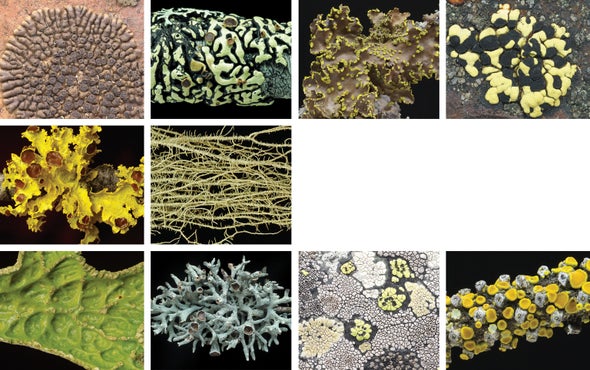Trevor Goward lets me lead, so we travel through the mixed forest at my pace. This is a nod to his rangy 6'5“ figure and the rapid strides he makes across barely discernible deer and bear paths on his land adjacent to Wells Gray Provincial Park in British Columbia. But mostly he is making space for my observations, my innate way of experiencing the landscape. What engages me? How do I see? I brake in front of a small, white-green growth on the trunk of an aspen. “Look there!” he says excitedly, inviting me to peer into the ragbag lichen through a magnifying lens. Suddenly I am in another world, looking down whorls studded with black dots into little caverns sprinkled with superfine dust.
Goward, white hair sticking up haphazardly, is wearing three flannel shirts on this crisp fall day. A hand lens hangs on a string around his neck, and an Australian shepherd named Purple trots along with him. He seems more mountain man than scientist, a naturalist in the tradition of Charles Darwin or Henry David Thoreau. Goward's scientific love is lichens—those growths that look like little mosses or colored crusts stuck to trees and rocks everywhere. He is inseparable from this place, where he has spent most of his adult life after growing up in a city south of the park. During my visit he tells me that now, in his 60s, he rarely leaves. “It has become my center of spiritual gravity,” he tells me.
It's not hard to see why. Most of the park has no road access and is rarely seen by humans. Wells Gray's 1.3 million acres were formed by volcanoes and glaciers; its river valleys, sheer rock mountains, alpine meadows and waterfall spray zones foster rich biodiversity. “I came to understand that the lichens here are pretty special,” among the world's most diverse, Goward beams. There are hundreds of species and counting. His careful attention to this one place, like conservationist Aldo Leopold's to his beloved Sauk County, Wisconsin, allows him to see connections that others might miss.
Goward stumbled on lichenology when he was educating himself about different branches of nature. “I made a point each year of learning as much as I could about a different taxonomic group. One year it was birds, then plants, then mushrooms, then insects.” When he got to lichens, he was smitten. Since then, despite being self-taught, he has become the go-to expert in central British Columbia for everyone from atmospheric scientists to gold prospectors to caribou biologists. Several lichen species have been named after him. He has published three taxonomic guides to lichens and has earned a spot as an associate member of the University of British Columbia's botany department.
And yet Goward is a maverick in the scientific world. His radical thought experiments about lichens, published in provocative essays available on his website, Ways of Enlichenment, have been both ridiculed and lauded—but largely ignored by most researchers because he holds no scientific degrees and because many of his ideas are not supported by rigorous data. Still, Goward's astute observations and deep thinking follow in the footsteps of Darwin's and Thoreau's approaches—which, much more than laboratory science, formed the basis of the theories of evolution and ecology. People who are open to considering his ideas say they come away with mind-expanding food for thought about lichens, biology and all life. Goward's longtime friend and sometimes co-author Toby Spribille, a lichenologist at the University of Alberta, says Goward's essays contain many gold nuggets: “Frankly, I think that they are brilliant.”
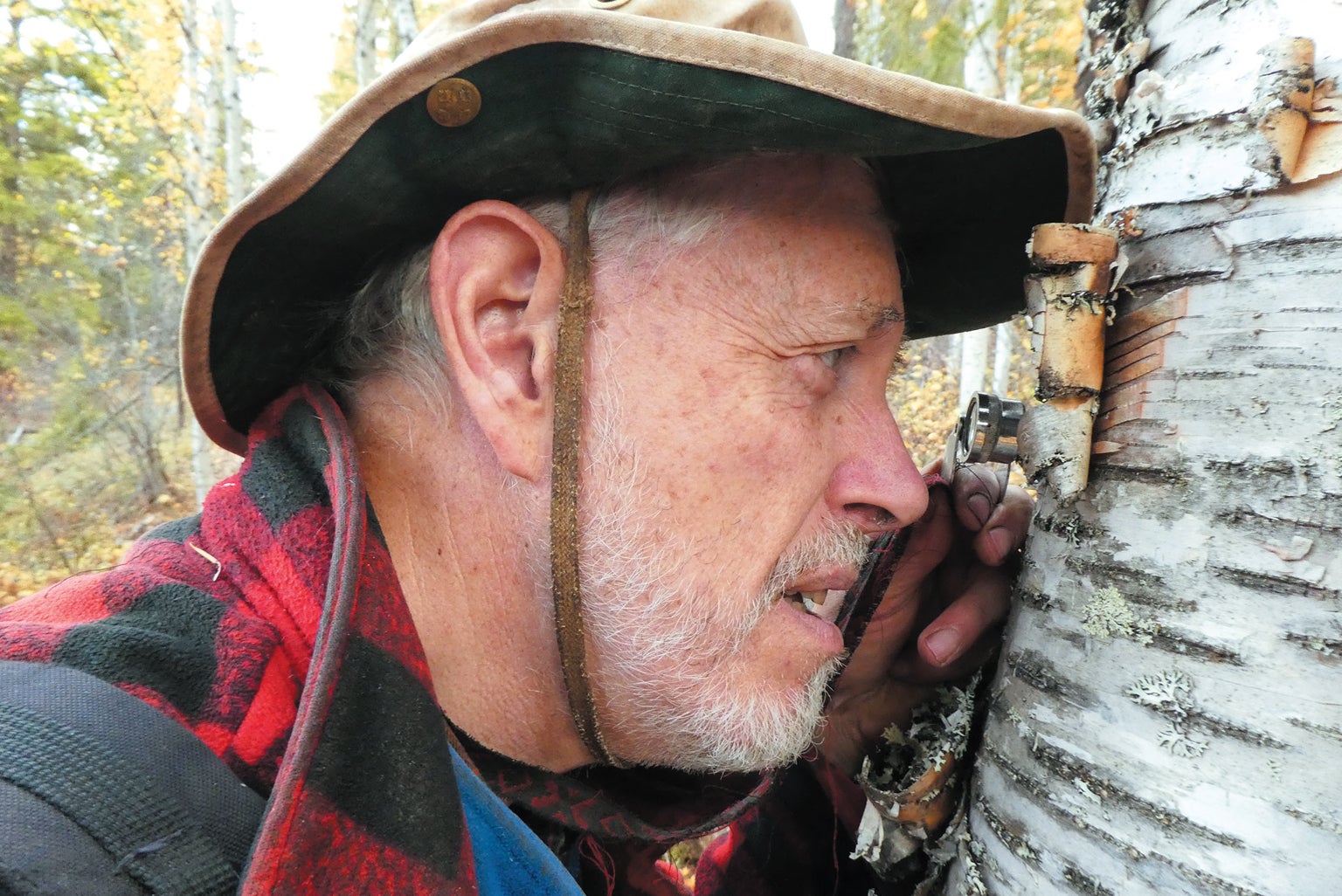
In the forest, Goward exudes a quiet, ebullient joy, the yang to his yin: a dark, realistic assessment of humanity's folly. When we stop, he leans on a sturdy walking stick and delivers extended soliloquies about how elements of the ecosystem interact. Reading the lichens informs him about soil chemistry, rain patterns and plant nutrients. He shows me a species growing on a hemlock, unusual because conifer bark is generally too acidic to support these kinds of lichens. So why are they there? In a 2000 paper Goward and his co-author André Arsenault found that the answer lies in a mature trembling aspen nearby. Water dripping from its branches becomes a leachate, which, when it falls onto the conifer's bark, lessens the acidity, allowing the lichen to thrive. They dubbed this interaction the drip-zone effect.
Goward learns from every life-form, including Purple, who waits on us patiently when she is not conducting her own observations: Scat from a pine marten. Red squirrel chatter! Although Goward knows French, Latin, and some conversational German and Swedish, he remarks that “mostly these days I speak lichen and maybe a bit of dog.” He says he can learn from Purple's way of seeing. That may seem eccentric, but Goward respects First Nations peoples' ways of knowing, and learning from animals is a storied human tradition.
Modern science tends to ignore outsiders. But reductionist science is not the only way of knowing things. Naturalists were the forebears of science. Humans once lived much closer to the land and were keen observers who had a profound understanding of nature's interactions. Today biology tends to be focused on molecules, and failure to look up from instruments in the lab to actually observe how pieces interact in the natural world sometimes undermines discovery. A clinical focus can lead scientists to miss big-picture connections, such as an emerging understanding that networks may be a more enduring life-form than individuals. Indeed, it was an idea from Goward that inspired Spribille's lab work while he was a postdoc at the University of Montana. That work paid off with a major advance: a July 2016 cover story in Science that rocked the ossified world of lichenology. The discovery called into question the very nature of the lichen symbiosis, shedding fresh light on how symbioses across biology work, how natural selection proceeds and even how to define life-forms.
Lichens are both ubiquitous and fascinating. Perhaps more than 500 million years old, they occur on every continent and can thrive in some of the most inhospitable places on Earth. They even survived for a year and a half in space, fully exposed to cosmic radiation, ultraviolet irradiation and vacuum conditions. The approximately 14,000 species of lichen come in a variety of forms: flat rounds on stones, scalloped leaves nestled among mosses, crusts clinging to tree bark, flowing strands hanging from branches, tiny trumpets tipped in red.
For centuries people thought lichens were plants (and then fungi). Then, in the 1860s, Swiss botanist Simon Schwendener discovered that they were a partnership between a fungus (an organism classified in its own kingdom because, unlike plants, it cannot make its own food) and an alga, an organism that feeds itself with photosynthesis but lacks the roots and stems of plants. The fungus apparently provided the structure of the lichen, and the alga provided food for the fungus via photosynthesis. (Later it was discovered that in some lichens, a cyanobacterium provided the food—and a handful of species contained both an alga and a cyanobacterium, along with the fungus.) Schwendener's discovery, at first resisted by the scientific community, ultimately made lichens the poster children for symbiosis, a mutually beneficial interaction among organisms. Since then, science has found symbioses across nature, including among the trillions of nonhuman microbes that cling to the scaffold of our bodies.
Science over the past two centuries has largely viewed molecules, cells and species as individuals. Symbiosis challenges that notion. “Within a lichen,” Spribille says, “algal cells and fungal cells may experience each other as individuals, but together they form a lichen that the feeding caribou sees as an individual: tasty.” Natural selection happens on both scales simultaneously. Just as light is both a wave and a particle, the fungus and alga are both individuals and parts of a whole. Science's reductionist focus has made it nearly impossible to fully understand symbiosis, Spribille says. “Ecology was supposed to be the science of natural process and synthesis, but its backbone is severely strained under the mathematics of individuality.”
In July 2016 Spribille and his co-authors took a major step forward in that understanding. Their big reveal in Science: many lichens have a second fungus in the house.
At the heart of their study is a pair of lichens to which Goward had drawn Spribille's attention: Bryoria fremontii, which is hairlike and often brown and eaten by northwestern Indigenous peoples, and a similar lichen, Bryoria tortuosa, which is often a yellowish green and is toxic, with high levels of vulpinic acid. The two posed a fascinating conundrum. Despite their differences, a genetic analysis published in 2009 by Saara Velmala of the University of Helsinki and her colleagues, on which Goward was a co-author, showed that the two species consisted of the same fungus and same alga. Spribille recalled how this perplexing finding infected them both. “[Goward] took the question of how could these two different lichens—one of which is toxic, for God's sake—be identical.” The question would not let go of Goward. And when Goward wrote about it, “by extension, it wouldn't let go of me.”
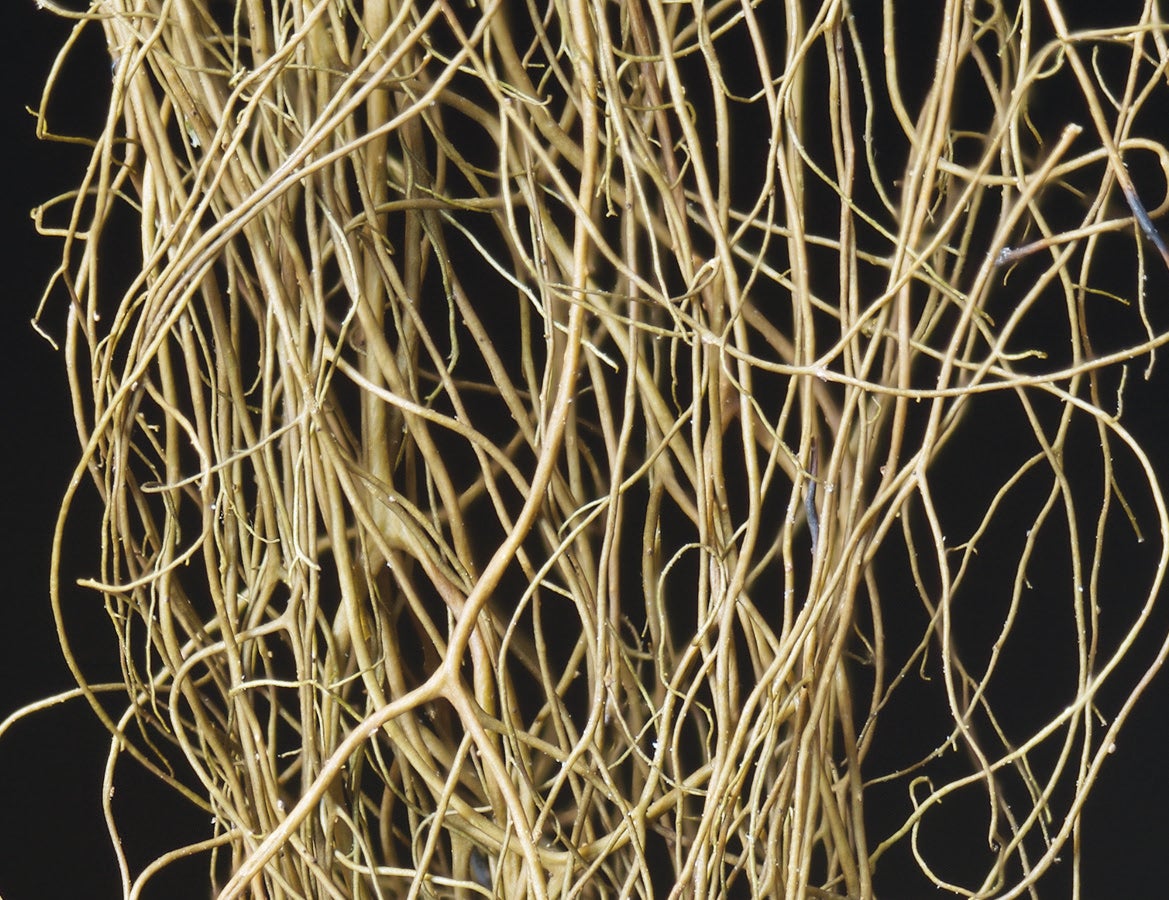
Aside from their different appearances and levels of vulpinic acid, Goward observed that the two lichens also had slightly different ecologies. Although they grew in some of the same places, B. tortuosa was found only on the summer-dry fringes of B. fremontii's larger territory. In 2009 he proposed that lichens are formed not by the shape of their fungal partner but by a series of decisions made during the developmental dance between fungus and alga. One lichen can look different from another that is composed of the same partners because it took different turns during development. Goward suggested that the difference between the two species of Bryoria might stem from each of them having a different relationship with a third life-form, a bacterium.
After five years of work in the lab, Spribille and his colleagues discovered that both Bryoria species did include a third partner. But it was not a bacterium; it was another fungus, known as a basidiomycete yeast. The toxic Bryoria contained a lot more of the yeast than the edible one. The researchers also demonstrated that the yeast was not a contaminant but had evolved with the other partners for more than 200 million years. Broadening their search to lichens across the globe, they found the yeast in 52 other sets (genera) of lichen. The finding dramatically expanded the world's understanding of lichens, opening the door to other insights. “Only now are we beginning to see that lichens have pulled off a rare feat in evolution: a large multicellular organism but built entirely of microbes—and here's the amazing thing—without a scaffold,” Spribille says. “Self-assembling, self-replicating, generation after symbiotic generation.”
Goward first became interested in B. fremontii and B. tortuosa when he read ethnobotanist Nancy Turner's 1977 paper about B. fremontii's importance to First Nations peoples. She said that women elders could easily distinguish the edible from the nonedible lichens. Although the two can have different coloring and a slightly different shape, they can also look quite alike. Elders use clues such as location, color and the types of neighboring lichens to tell them apart. When Stuart Crawford, a friend of Goward's with a degree in ethnobotany, showed bundles of the two lichens to an elder and conservationist from the Neskonlith band, the late Mary Thomas, she correctly identified the edible one every time.
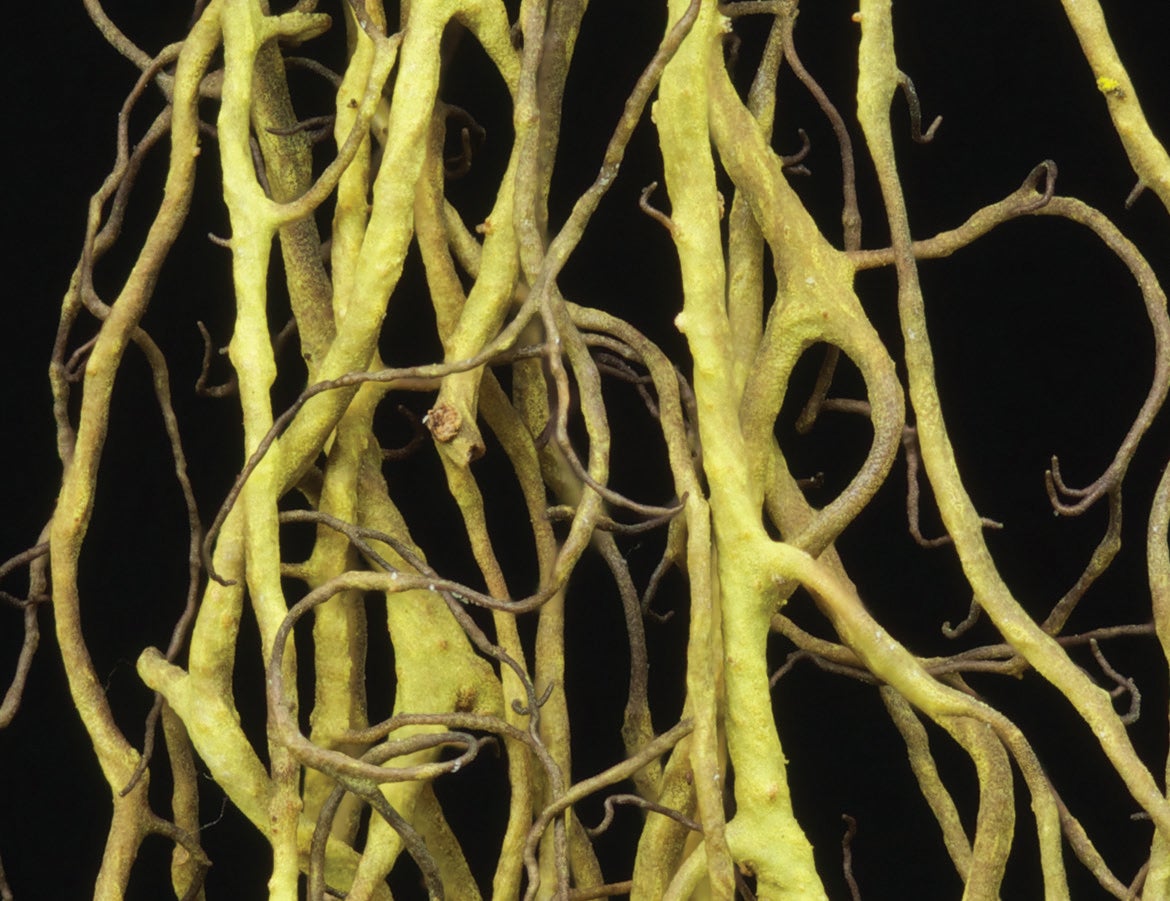
Local people's wisdom does not always jibe with scientific explanations, Crawford says, but the result, based on observation, is correct. The locals told Crawford that they wait for B. fremontii to “ripen” on the tree. In fact, lichens do not ripen as do fruits and vegetables, but the darker color and its growth pattern on trees help the people distinguish it from its poisonous twin. These other realms of knowledge about Bryoria would have added interesting context to the Science paper, Spribille says, but “it didn't fit the word limit.”
Three months after the paper was published, Crawford, who knows Spribille through Goward, got around to telling him something amazing. For years Crawford had been collecting writings from around the world—ancient Egypt, modern Mexico, medieval Russia, the Biblical Middle East, a European cookbook from the 1950s—of people using lichens to make bread and alcoholic beverages. In some cases, they were using them explicitly for leavening and fermentation. On some level, Crawford realized, people knew that lichens contained yeast or functioned like yeast. When he was working on his master's degree in Victoria, B.C., Crawford discussed the notion with a local microbrewer, who told him, “If you can figure out the recipe, I'll do a batch of beer” with it.
Spribille's openness to Goward's unconventional ways of thinking is perhaps a reflection of his hard-won path to science. He grew up in a fundamentalist Christian family in northwestern Montana, where his parents pulled him out of school after fourth grade to protect him from “the influences of the world.” Spribille is telling me this via Skype from Austria, where it is late at night and his wife and young daughter are sleeping. His rectangular glasses frame blue eyes that frequently squeeze shut while he is talking, as if communicating with me is a little painful.
Circumstance could not restrain Spribille's intellectual curiosity. Intrigued about organisms he saw in the wild, he sought answers from biologists at a local U.S. Forest Service outpost. Eventually they recommended him for a job surveying vascular plants, and he could call up professors and authors with his burning questions. Goward was on Spribille's call list. “Trevor kept me on for two and a half hours,” Spribille says fondly. That was decades ago. They have co-written several papers, and “we still haven't run out of things to talk about.” Early on, Goward told Spribille that he had ideas that would turn lichenology upside down. “He said that I was delusional,” Goward recalls. “But he wanted to hear the ideas.”
Ultimately Spribille felt a keen desire for a formal education. He took the high school equivalency examination and found an opportunity to go to college in Germany. He later earned a Ph.D. in lichenology at the University of Graz in Austria and in 2017 joined the faculty at the University of Alberta, where he studies the ecology and evolution of symbiosis. During his postdoc at the University of Montana, he met John McCutcheon, one of the co-authors on the Science paper and head of the lab in which the work was done (McCutcheon has since moved to Arizona State University). McCutcheon credits the breakthrough to technological advances that allowed the researchers to find the tiny yeast and to cooperation among diverse co-workers. But also critical, he says, was Spribille's ability to look beyond what was assumed to be true. The human mind's tendency to restrict itself is part of what kept this yeast hidden for so long, he says: “When you're used to thinking there's just one fungus there, that's what you see.”
Spribille, in turn, credits Goward with having “a huge influence on my thinking. [His essays] gave me license to think about lichens in a way that was not orthodox and freed me to see the patterns I worked out in Bryoria with my co-authors.” Yet even with that, Spribille says, “one of the most difficult things was allowing myself to have an open mind to the idea that 150 years of literature may have entirely missed the theoretical possibility that there would be more than one fungal partner in the lichen symbiosis.”
Although he appreciates his education, Spribille maintains that academia's emphasis on the canon of what others have established as important is inherently limiting. “You have this culture of prepared minds that makes it extremely difficult to think outside the box,” Spribille says. “It creates the box.”
That sounds plausible to Jonathan Foley, executive director of Project Drawdown, who has a Ph.D. and had an acclaimed academic career. (Foley serves on Scientific American's board of advisers.) When it comes to ideas, “the ivory tower is now an ivory fortress,” he says. Academic culture's incentives to publish in accepted journals, get funding and obtain tenure are “not aligned with being wildly creative.” After Sputnik, science became hyperprofessionalized, Foley says—“kind of Science, Inc. I think we lost part of our souls.” The extreme specialization required for the biotech-heavy, molecule-focused world of biology today eliminates time to study taxonomy or epistemology. “There are people getting degrees in biological sciences at the best universities in America today who don't know the names of anything outdoors, who have never studied anything larger than a cell,” Foley notes. That means a lot of biologists are lab-bound and rely on people like Goward to find the species they would like to study or even to suggest ideas for studies.
Also worrisome to Spribille is that his own students are petrified of being wrong, a psychological state incompatible with breakthroughs. For a counterexample, he points to Goward. In the case of Bryoria, Goward surmised that a third partner was present, although he incorrectly thought it was a bacterium. But being correct “is not the criterion of a brilliant mind,” Spribille says. On the contrary, brilliant minds are characterized by indefatigable curiosity and questioning, traits that Spribille tries to encourage in his students. “I tell them, ‘Just put all the ideas out there. Nobody here is going to make you feel bad about throwing out an idea that we may then not use.' I live by that.”
Some of the most serious problems science is trying to solve today—climate change, loss of biodiversity, food and water security—require big, integrated views from multiple perspectives. Stepping out of the lab and back into nature to observe how natural systems actually work is a critical first move. One biologist at the University of the South challenged himself to try it. David George Haskell spent a year sitting in a square yard of old-growth forest in Tennessee, just observing, and wrote a Pulitzer-nominated book about it, The Forest Unseen. The experience was profoundly humbling, he says. “You wake up to the extent of your own ignorance. I'd been through decades of training and teaching as a biologist and had published scientific papers and so on, and sitting down in the woods, I realized I know so, so little about this place.” From that humility sprouted seeds of curiosity and dozens of questions about relationships among plants and animals, their ecological history, and how that related to climate and geology. Haskell eventually became an adviser to the New York City–based Open Space Institute, helping it to identify lands for conservation that are most likely to be climate-resilient.
If knowledge comes mostly through reading scientific literature, “we're several steps removed from the actual phenomena we're discovering,” Haskell explains. And while instruments are important for helping scientists understand the world, “our bodies come preinstalled with all these amazing apps, and they connect directly into our consciousness,” he says. “Through literally coming back to our senses, we can learn so much about the world.”
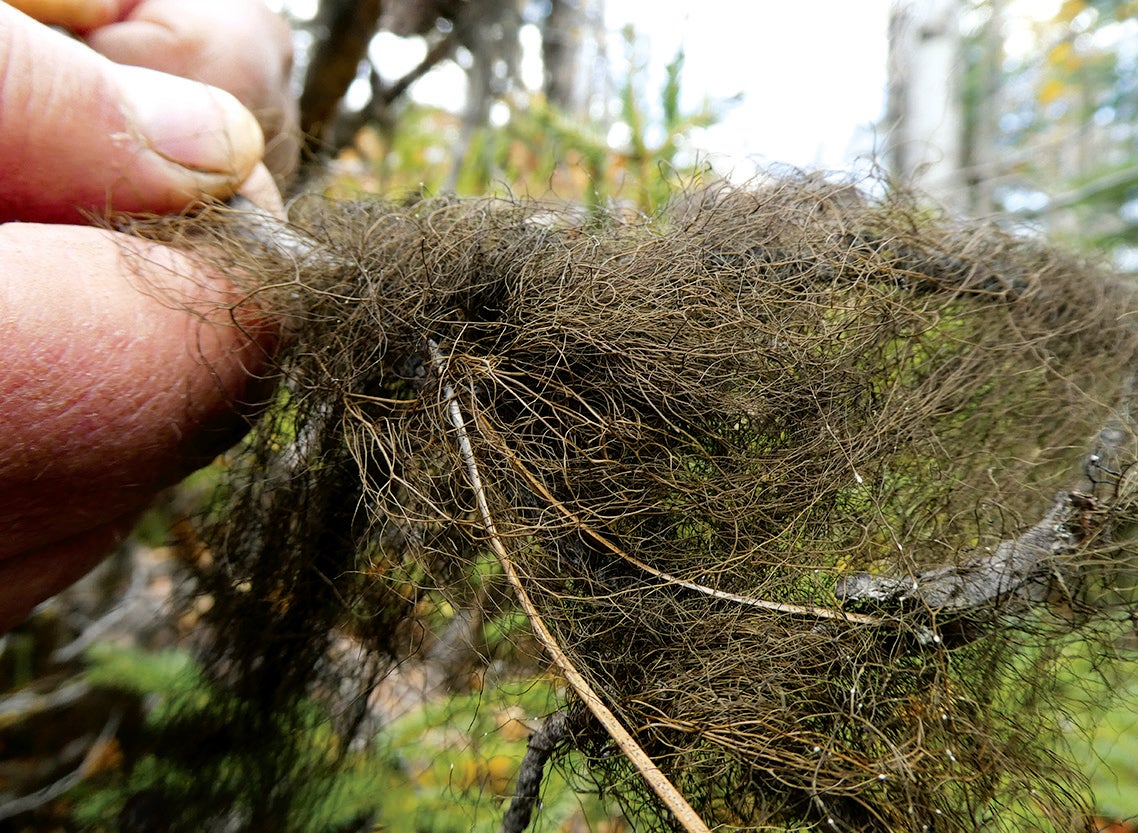
Goward has turned this ethic into a way of life. His house, named Edgewood Blue, on 10 acres abutting Wells Gray, has running water for a shower and sinks but no toilet. As I put on my coat and shoes one evening to head to the outhouse, Goward's partner, Curtis Björk, a botanist, encourages me to look up and admire the Milky Way, vivid in the lack of light pollution. When I ask Goward why he and Björk have no toilet, he says they appreciate being forced to go outside every day, even in the depths of winter. On trips to the loo he has seen the Northern Lights and passing moose. When I jokingly whimper about getting wet or cold, or chomped by summer mosquitoes, or even stalked by the cougar that recently swiped a neighbor's pigs, Goward is unapologetic: “That's real. Life isn't always comfortable.”
To Goward, the real danger lies in separating ourselves from the natural world, living ensconced in cities, ignorant of how badly we are degrading nature. Haskell agrees and points out that this separation has ethical implications. “Trees, fungi, salamanders … these are our blood kin, if you believe Darwin.” When we do not know the world, we have an imperfect sense of right and wrong in how our own behavior impacts ecosystems, he says.
But for scientists who may not have a year, or 30, to spend contemplating the wild, collaborations or friendships with people outside the academy or from different disciplines can open space for new discoveries, as they did for Spribille.
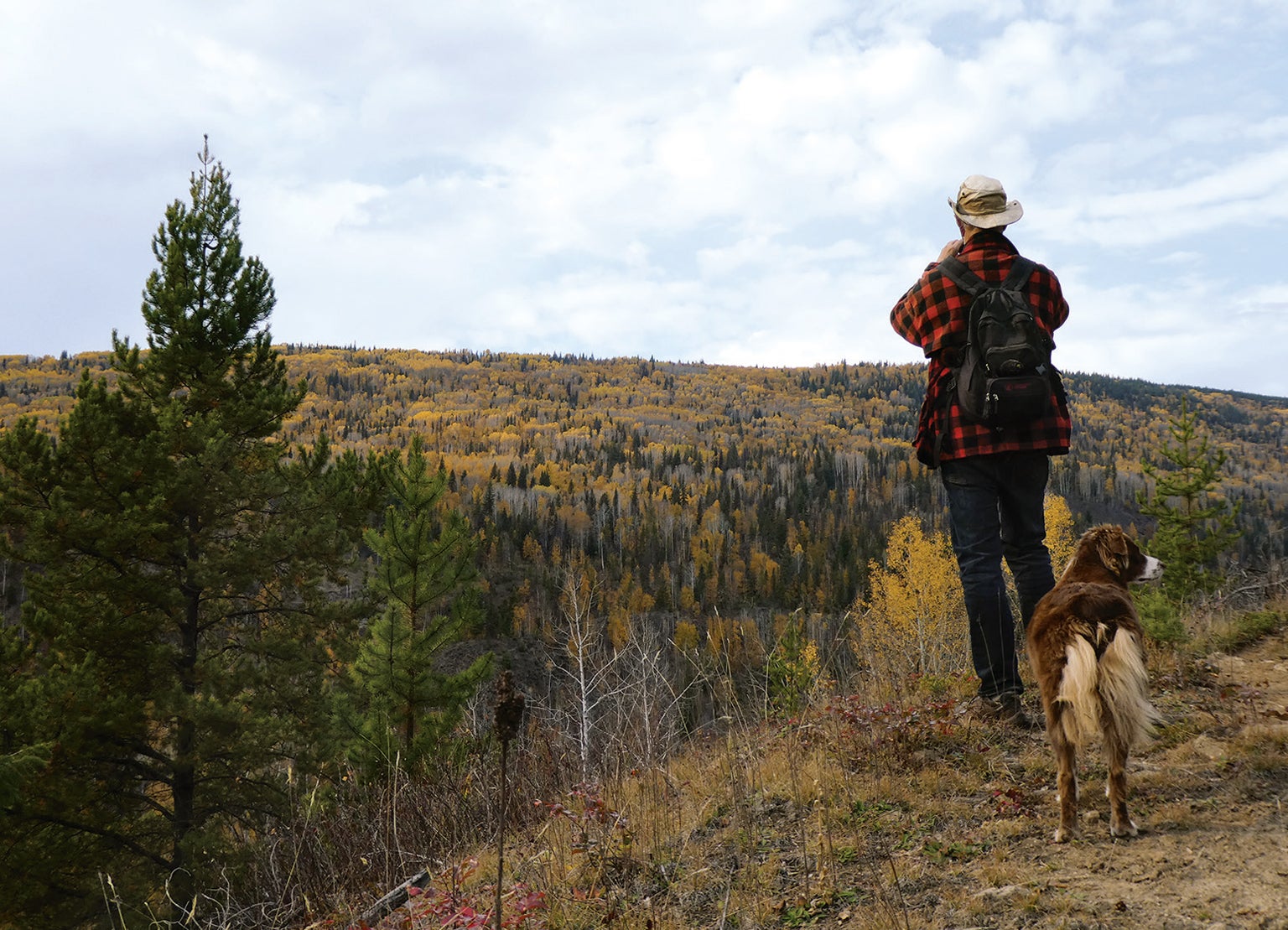
The decor at Edgewood is dominated by books, which serve as de facto wallpaper, lining homemade shelves in most rooms. The kitchen is Björk's fiefdom, and when dinner is ready, he sends Purple to fetch the humans. Purple eats at the table with us, displaying excellent manners.
Also served at the table are wide-ranging discussions. “We try to make this a place where anyone can express their ideas,” Goward pronounces. The strengths and failings of modern science are a frequent theme, with conversation on the topic driven primarily by abiding affection for it. Life and human relationships also take the spotlight, sometimes with quirky analogies to lichens. Although Goward is confident—sometimes bordering on arrogant—about his own ideas, he is eager to consider new information. His dialogue is peppered with references to authors. I mentioned Haskell's book and an essay by the late Ursula K. Le Guin, and he had read them by the next time we talked.
With the scientific world often reluctant to publish him, Goward spreads his ideas one person at a time. He and Björk host an ongoing parade of biologists, aspiring naturalists, poets, geographers, ecologists, astrophysicists and journalists who stay for a day or a week or longer in return for doing a bit of work at Edgewood. Both Spribille and Crawford have become regular guests. “I've done a lot of landscaping on his place,” Crawford says proudly. “We have great and intellectually stimulating conversations.”
Goward would like to create a more formal venue for learning, to increase “biological literacy” in the next generation, and has donated half of his land as a research center to Thompson Rivers University in nearby Kamloops, where he grew up. He also periodically invites people from various disciplines to meet for a few days of discourse.
On my visit Goward delves into one of his pet lines of inquiry: What are lichens, really? Are they organisms? Fungal greenhouses? Algal farmsteads? Ecosystems? Networks?
What you think lichens are might depend on your perspective. Lichens have the scientific names of their fungi, which can create an implicit bias toward seeing the fungus as in charge, a limited perspective that Goward admits to having once upon a time. Today he sees lichens as a kind of koan. “The lichen by its very nature exists at a portal, a doorway,” he says. “If you look in one direction, it's an organism. If you look in the other direction, it's an ecosystem.” Goward's essays argue for seeing lichens not as their fungal or algal parts or even as ecosystems or organisms. Rather they are all these things, biological systems encapsulated in a membrane: lichens as emergent property. After all, the lichens that were sent into space survived when their algae alone did not.
Thinking of lichens as systems fits with a larger shift in biology from viewing the individual as the fundamental unit of life to highlighting community or partnerships. “Whether it is the microbiome within the human body, or trees interacting with fungal partners belowground, or lichens … we're seeing that networked relationships are more fundamental and persist longer within biological systems than individuals do,” Haskell says.
To Goward, lichens are the organisms that are most obviously about relationships. As such, they provide insights into all of life. “Lichens are my window,” he says, “but it's the act of looking at the world that's the interesting thing.” Systems hold together in the long term only if the parts consider themselves integral to the whole and if the whole protects the parts, as lichens do. “That's what's going wrong with us,” he says. “As individuals, we're not concerned with the whole.”
